Best Cordless Rotary Hammer Drills — Buyers Guide, Top Pick, and Comparison
Providing mains-free operation, but without sacrificing grunt or brawn — cordless rotary hammer drills are the masters of portable dense material demolition and drilling. Driven by long-lasting lithium-ion cells — typically with up to 45 minutes of run time from a single charge — these DIY and pro-grade units can tackle cement, masonry, and brickwork. High impact rates, SDS+ compatibility, and elevated efficiency brushless motors make light work of hardcore materials. And, featuring rotation, hammer and rotation, or hammer only functions — there’s a drilling setting for every application.
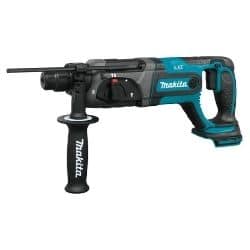
- Charges in just 45 minutes.
- Shock absorbent handle.
- D-handle for additional pushing power.
Cordless Rotary Hammer Drills Information
Cordless Rotary Hammer Drill Comparison Table
| IMAGE | PRODUCT | DETAILS | ||
|---|---|---|---|---|
|
Best for Concrete 
|
Best for Concrete
|
Makita XRH04Z
|
Features
|
Check Price at Amazon Makita XRH04Z Review Makita XRH04Z Review |
|
Best Compact 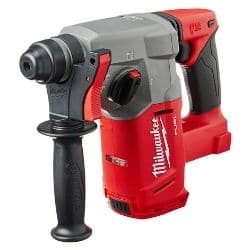
|
Best Compact
|
Milwaukee 2712-20
|
Features
|
Check Price at Amazon Milwaukee 2712-20 Review Milwaukee 2712-20 Review |
|
Best High Impact 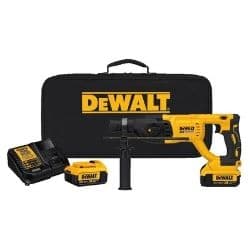
|
Best High Impact
|
DeWalt DCH133M2
|
Features
|
Check Price at Amazon DeWalt DCH133M2 Review DeWalt DCH133M2 Review |
|
Best for Power 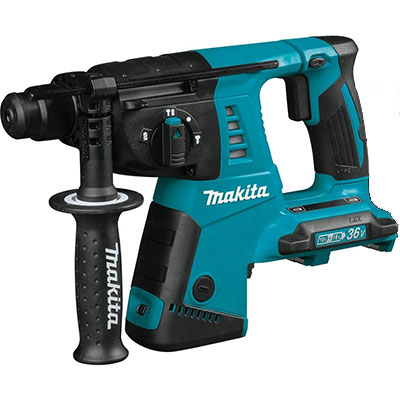
|
Best for Power
|
Makita XRH05Z
|
Features
|
Check Price at Amazon Makita XRH05Z Review Makita XRH05Z Review |
|
Best for DIY 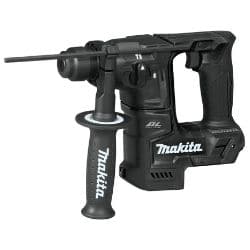
|
Best for DIY
|
Makita XRH06ZB
|
Features
|
Check Price at Amazon Makita XRH06ZB Review Makita XRH06ZB Review |
Best Cordless Rotary Hammer Drills Buying Guide
Packing some serious punch while offering the ultimate in portability and operational freedom — cordless rotary hammer drills are the go-to machines for DIYers and trade pros attacking masonry, brickwork, and concrete.
Knocking out in excess of 4000 bpm, these hardcore units are the masters of dense material drilling, channeling, and small-scale demolition. Built to withstand extreme use and abuse, cordless rotary drill machines are ideal for home renovations and trade-site applications.
However, what separates these mighty mothers of destruction from standard rotary drills is their cordless functionality — removing the annoying and hazardous use of extension mains cables, permitting effortless high-level use, and allowing you to operate away from power outlets.
When choosing your ideal rotary hammer drill cordless machine, I suggest checking out:
- Two or three drill settings.
- Brushed or brushless motor.
- Voltage and mAh of the battery.
- Complete kit or tool-only.
- Handle type.
- LED lamp inclusion.
- Vibration absorption features.
Cordless Hammer Rotary Drills Vs Standard Cordless Hammer Drills
One of the most common areas of confusion surrounding cordless rotary units — especially for newbies to the impact drill arena — is how they differ from their close cousins, cordless hammer machines.
Both of these categories share two key features: delivering hammer action in addition to standard rotational drilling, and naturally being powered by a battery pack instead of a mains lead.
The distinction between these groups is the hammering action itself. A traditional hammer unit utilizes a gear-driven clutch to provide the pounding motion — whereas, a rotary hammer drill incorporates two pistons to pummel the target material.
Known as flying and drive pistons, these crucial components knock out greater force than a clutch mechanism can provide — meaning they’re the ultimate masonry drilling and demolition tools.
Do You Need a Rotary Cordless Hammer Drill?
If your projects involve attacking the densest of materials — often in high-level locations or on-site with problematic access to mains power — it’s worth considering a rotary cordless unit.
Providing more impact per inch than a regular hammer drill, these units are excellent at:
- Driving holes in masonry.
- Creating anchor points in concrete footings.
- Pinning cement wall forms.
- Channeling prefabricated concrete for pipes and wiring.
- Preparing bolt holes for HVAC units, guttering, downpipes, to brickwork.
- Light-to-medium demolition.
- Attaching stanchions to masonry.
Cordless Hammer Rotary Drills Safety Precautions
As with any type of drill, you need to follow sensible safety procedures to protect yourself and others.
However, the inherent dangers are exacerbated when using a cordless rotary machine — not just because you’re wielding a high-impact weapon in your hands, but also because of the volatile material you’re addressing.
Brick, cement, concrete, and bonded hardcore contain crystalline silica — often in the form of quartz. Drilling, boring, and chipping away at these materials can release airborne particles of silica — which then become respiratory hazards.
Recent research indicates that mechanically disturbing these particles on construction sites can elevate silica levels to over 280 times the National Institute for Occupational Safety and Health’s (NIOSH) exposure limits.
Breathing in silica dust can lead to:
Hence, it’s crucial when using one of the most powerful cordless rotary hammer drill units that you take necessary precautions, including:
- Wearing a respiratory mask.
- Operating in a well-ventilated area.
- Creating airflow with an electric fan.
- Taking frequent breaks.
- Where possible, working outside.
- Cleaning the operational area frequently — while still wearing your mask.
- Dampening down the surface with water to reduce airborne dust.
How to Choose the Best Cordless Rotary Hammer Drills
However, individual models can vary in particular features that may, or may not, be suitable for the majority of your drilling projects.
Hence, I suggest when seeking your ideal machine, you consider:
Number of Drilling Modes
At the very least, even the most basic rotary cordless tool will have two drilling options — rotation, and rotation with hammer.
Rotation is your back-to-basics, no-nonsense, drilling setting — permitting you to bore holes into woods, metals, and acrylics. Rotation with hammer, as the name suggests, combines this turning action with multiple impacts — making it the ideal selection for creating holes in robust masonry and brickwork.
However, true pro-grade units — such as the 2712-20 Milwaukee cordless rotary hammer drill — boast an extra drilling mode, hammer only.
This makes the tool ideal for pure demolition work — pounding away with no rotation of the drill bit or chisel head. Bear in mind that these three-setting machines are slightly harder on the pocket than their two-mode counterparts — and may be overkill for the average home DIYer.
Brushless Motors
You may not be particularly interested in the minutiae of the motor workings of your rotary cordless drill — but whether to go brushed or brushless is a valuable consideration.
Brushless motors — due to the lack of, well, brushes — are more efficient than brushed types. With no contact made between the rotor and stator, there’s little loss of energy to heat and friction — meaning that the lifespan of the cordless battery is elevated and you can operate for longer without recharging. The XRH06ZB Makita cordless rotary hammer drill is an excellent example of a brushless tool.
Furthermore, this reduces internal temperatures, which not only increases the longevity of your tool by shielding the unit’s electrical components, but also lowers the heat-in-your-hand — making for a more pleasant drilling experience.
Conversely, brushed motors will use more energy, draining your battery faster. Their only advantage is that they’re more cost-effective to manufacture — meaning a more affordable unit.
Lithium-Ion Cell Type
Typically, the higher the voltage of the power cell, the faster and more torque delivered by the cordless rotary drill. However, this is more of a generalization than a rule — as it can also depend on a brushed or brushless motor and/or internal gearing.
I would suggest of most importance is checking out the mAh rating of the lithium-ion battery — as this determines the length of time you can run the unit from a single charge. At the very least, seek out a tool with a minimum 4.0 mAh — genuine contractor-grade units, such as the Makita XRH04Z, have 5.0 mAh or higher.
Tool Only or Complete Kit
Remember being an excited child at Christmas, unwrapping your present to find your dream toy, and then suffering the heart-wrenching blow as you discover batteries are not included?
Well, you can relive this childhood trauma with your new rotary cordless hammer drill.
Many high-end units are supplied tool-only — that is, with neither a power cell nor charger supplied. While this may not be an issue if you already own a stack of model-compatible batteries — it can be disappointing for newbie cordless users.
Hence, always check whether these two crucial elements, if required, arrive complete with your new tool. The DCH133M2 DeWalt cordless rotary hammer drill comes with a carry case, lithium-ion cell, and a charger in the box.
Impact Rate
However, as most cordless hammer rotary drills have an unofficial industry standard of 4000-4800 bpm (blows-per-minute) — differentiation can be challenging.
I would suggest that it’s more useful to check out the force delivered by these blows — measured in foot-pounds (ft-lbs). The higher this rating, the more effectively your tool will power through cement.
Handles
All rotary hammer cordless drills include two handles — a molded rear and a removable auxiliary front. These are crucial — otherwise, it would be impossible to adequately and safely control the powerful hammer action.
However, there are two features you should look out for.
Firstly, investigate whether the auxiliary grip is rotatable — and the extent of this rotation. Some units facilitate full 360-degree positioning, allowing you to tailor the handle to suit your drilling style, angle of address, and demands of your base material.
Secondly, examine whether the rear molded handle has a D-design. Although not crucial for all users, it does allow for elevated grip and pushing force — necessary if your projects involve tackling the densest of masonry. The best rotary hammer drill for concrete — the Makita XRH04Z — possesses this feature.
Vibration Absorption
Hammer drilling with a monster rotary cordless machine can be tough on the digits, hands, and arms.
Repetitive pounding — especially over extended periods — can induce aches, pains, and fatigue. In extreme cases, this constant oscillation can cause permanent damage to the nervous and vascular systems.
I therefore seriously suggest that you look for a machine that has both vibration-absorbing casing and handles — for example, the Makita XRH05Z — shielding you from harm and delivering a more pleasing drilling experience.
LED Lamp
A common feature among cordless drills, including rotary examples, is the inclusion of an in-built LED lamp.
While not crucial for many masonry applications, it can be a bonus if you’re operating in dimly lit locations such as beneath floors, in attics, or inside basements.
Conclusion
Permitting run times of up to 45 minutes from a single charge, high-impact rates, and an unmatchable pounding grunt delivered by twin pistons — these extreme tools are ideal for masonry, brickwork, and concrete applications.
As suitable for serious DIYers as they are for trade pros, these machines are the ultimate portable drills for dense materials. Always investigate whether your chosen tool arrives with a battery and charger to prevent later disappointment — and that it boasts a vibration-busting build to enhance your drilling experience.
Sure, for general household timber, metal, and plastic projects — they’re complete overkill. But, if your jobs involve tackling the most hardcore of materials — get yourself one of the best cordless rotary hammer drills.
Cordless Hammer Rotary FAQs
Q: What Is the Best Hammer Cordless Rotary Drill?
After examining the opinions of industry experts, researching online cordless rotary hammer drill reviews, and applying my own experience — I believe that the Makita XRH04Z, with its triple drill settings and 5.0 mAh included battery is the best portable masonry tool.
Q: What Is a Cordless Rotary Hammer Used For?
Mains-free, rotary cordless hammer drills are utilized for chiseling, chipping, channeling, and drilling into dense masonry and brickwork.
Q: What’s The Difference Between Rotary Hammer and Hammer Drill?
A rotary hammer features two pistons to deliver impact to the target material, while a standard hammer drill utilizes a geared clutch.
Q: Can a Rotary Hammer Break Concrete?
Yes. Significant bpm (blows per minute) rates combined with high foot-pounds of impact allow both cordless and corded rotary hammer drills to break, demolish, and drill concrete.
Q: How Long Does a Cordless Rotary Drill Hammer Battery Last?
The operational time from a single charge will depend on what settings you apply to your rotary cordless hammer drill. Using the hammer and rotational action simultaneously, and running the machine at the highest rpm level, will deplete the lithium-ion cell more rapidly.
At most, you can expect around 45 minutes of run time from one charge.
Q: What Size is the Chuck of a Rotary Drill Cordless Hammer?
The vast majority of cordless hammer rotary drills have an SDS-compatible chuck. This is crucial, as it permits the drill bit to slide forward and backward during the hammering motion.
Q: What Is the Best Make of Rotary Cordless Hammer Drills?
Based on my experience, customer rotary hammer drills reviews, and the opinions of trade experts — the most reliable, durable, and high-quality manufacturers are Bosch, Makita, DeWalt, and Milwaukee.
